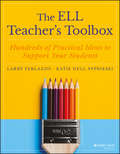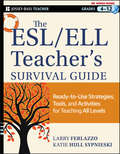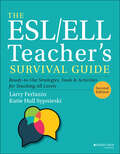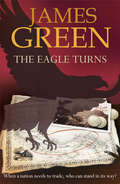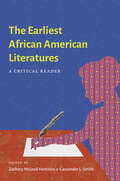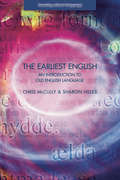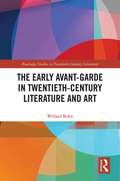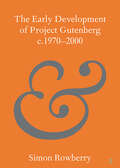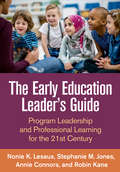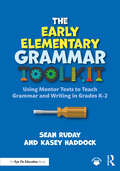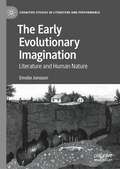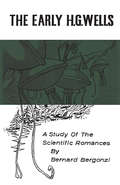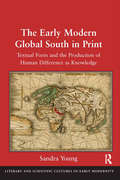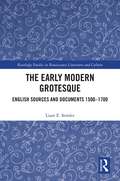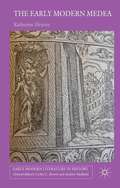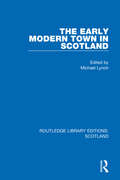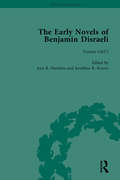- Table View
- List View
The ELL Teacher's Toolbox: Hundreds of Practical Ideas to Support Your Students (The Teacher's Toolbox Series)
by Larry Ferlazzo Katie Hull SypnieskiPractical strategies to support your English language learners The ELL Teacher’s Toolbox is a practical, valuable resource to be used by teachers of English Language Learners, in teacher education credential programs, and by staff development professionals and coaches. It provides hundreds of innovative and research-based instructional strategies you can use to support all levels of English Language Learners. Written by proven authors in the field, the book is divided into two main sections: Reading/Writing and Speaking/Listening. Each of those sections includes “Top Ten” favorites and between 40 and 70 strategies that can be used as part of multiple lessons and across content areas. Contains 60% new strategies Features ready-to-use lesson plans Includes reproducible handouts Offers technology integration ideas The percentage of public school students in the U.S. who are English language learners grows each year—and with this book, you’ll get a ton of fresh, innovative strategies to add to your teaching arsenal.
The EMC Write-In Reader: Reading Strategies and Test Practice
by EMC Paradigm Publishing CompanyRedwood Level Reading Strategies
The EMC Write-in Reader: Reading Strategies and Test Practice ( Cedar Level)
by Laurie SkibaA Literature and Language Arts textbook, The EMC Write-In Reader offers a rich reading experience, skill development, and standardized test practice.
The EMC Write-in Reader: Reading Strategies and Test Practice, Birch Level
by EMC/Paradigm Publishing Editorial staffThe EMC Write-in Reader shows you how to use reading strategies before, during, and after reading and includes activities that develop your comprehension, fluency, and vocabulary skills. This portable anthology guides you in using reading strategies--reading tools that help you get more meaning from what you read. Questions and tips in the margins prompt you to record your thoughts and notes as you read.
The ESL / ELL Teacher's Survival Guide
by Larry Ferlazzo Katie Hull SypnieskiA much-needed resource for teaching English to all learners The number of English language learners in U. S. schools is projected to grow to twenty-five percent by 2025. Most teachers have English learners in their classrooms, from kindergarten through college. The ESL/ELL Teacher?s Survival Guide offers educators practical strategies for setting up an ESL-friendly classroom, motivating and interacting with students, communicating with parents of English learners, and navigating the challenges inherent in teaching ESL students. Provides research-based instructional techniques which have proven effective with English learners at all proficiency levels Offers thematic units complete with reproducible forms and worksheets, sample lesson plans, and sample student assignments The book?s ESL lessons connect to core standards and technology applications This hands-on resource will give all teachers at all levels the information they need to be effective ESL instructors.
The ESL/ELL Teacher's Survival Guide: Ready-to-Use Strategies, Tools, and Activities for Teaching All Levels (J-b Ed: Survival Guides #175)
by Larry Ferlazzo Katie Hull SypnieskiMaximize the educational potential of your ESL/ELL class with this singular resource The ESL/ELL Teacher's Survival Guide: Ready-to-Use Strategies, Tools, and Activities for Teaching English Language Learners of All Levels, 2nd Edition offers readers a comprehensive range of instructional strategies and educational resources for teaching English. The newly revised 2nd Edition includes brand new chapters on: • Working with Long-Term English Language Learners • Teaching English internationally • Teaching Elementary Age ELLs • Teaching Adult ELLs • Teaching ELLs with learning challenges • Culturally Responsive Instruction • Effective online instruction • Working with co-teachers and para-professionals In addition to the new chapters, The ESL/ELL Teacher's Survival Guide contains updated material on topics including math, science, social studies, Common Core Standards, the Next Generation Science Standards and 150 pages of new, highly engaging content. An essential resource for anyone involved in teaching English as a Second Language to students of all ages, this book is perfect for general education teachers and ESL specialists for students in grades six through twelve. It’s also highly instructive for teachers of adult ESL classes, elementary and teacher educators, and resource specialists.
The Eagle Turns: Agents of Independence Series (Agents Of Independence Ser. #3)
by James Green1850 and America is violently divided on the issue of slavery. When President Zachary Taylor dies, suddenly and under questionable circumstances, it is left to his Vice President, Millard Fillmore, a weaker man, to find ways to keep the North and the South apart.In New York, child of Irish immigrants, Matthew O’Hanlon is fired from his job as a newsman on the Herald but, surprisingly, finds work as Foreign Correspondent for the Associated Press in Panama City. There he is given accommodation with a Dr Couperin, his wife and beautiful daughter, Edith, but finds himself caught up with the secret agents protecting America’s commercial interests during the struggle for control of Panama’s trade routes and, as it crashes about him, realises that he has been living in a house of cards. Set against the Gold Rush and the opening up of California and the OregonTerritories, when the United States walked a narrow and dangerous line, The Eagle Turns charts the course of history as America’s Secret Services struggle to bring prosperity amid the conflict.
The Earliest African American Literatures: A Critical Reader
by Zachary McLeod Hutchins, Cassander L. SmithWith the publication of the 1619 Project by The New York Times in 2019, a growing number of Americans have become aware that Africans arrived in North America before the Pilgrims. Yet the stories of these Africans and their first descendants remain ephemeral and inaccessible for both the general public and educators. This groundbreaking collection of thirty-eight biographical and autobiographical texts chronicles the lives of literary black Africans in British colonial America from 1643 to 1760 and offers new strategies for identifying and interpreting the presence of black Africans in this early period. Brief introductions preceding each text provide historical context and genre-specific interpretive prompts to foreground their significance. Included here are transcriptions from manuscript sources and colonial newspapers as well as forgotten texts. The Earliest African American Literatures will change the way that students and scholars conceive of early American literature and the role of black Africans in the formation of that literature.
The Earliest English: An Introduction to Old English Language (Learning about Language)
by Chris Mccully Sharon HillesThe Earliest English provides a student-friendly introduction to Old English and the earliest periods of the history of the English Language as it evolved before 1215. Using non-technical language, the book covers basic terminology, the linguistic and cultural backgrounds to the emergence and development of OE, and the OE vocabulary that students studying this phase of the English language need to know. In eight carefully structured units, the authors show how the vocabulary of Old English contains many items familiar to us today; how its characteristic poetic form is based on a beautiful and intricate simplicity; how its patterns of word building and inflectional structure are paralleled in several present day languages and how and why the English language and its literature continued to change so that by the mid-12th century the English language looks more like the 'English' that we are familiar with in the 21st century. Features of the book include: the provision of accessible guides to some important 'problem topics' of classical OE stimulating cross-linguistic comparisons, e.g. the pronoun system of OE as compared with the pronoun system of present day Dutch cleverly laid out translation exercises, with structural help in the form of selective glossaries careful division into eight units, designed for both classroom use and self-study Written in a clear and accessible manner, The Earliest English provides a comprehensive introduction to the evolution of Old English language and literature, and will be an invaluable textbook for students of English Language and Linguistics.
The Early Avant-Garde in Twentieth-Century Literature and Art (Routledge Studies in Twentieth-Century Literature)
by Willard BohnThis book focuses on avant-garde literature and art in Europe and America during the first quarter of the twentieth century. It examines five movements that shaped our response to the demands of the modern age and contributed to the creation of a modern sensibility: Cubism, Futurism, the Metaphysical School, Dada, and Surrealism. Each of these arose in response to recent scientific, technological, and/or philosophical developments that drastically affected modern civilization. In turn, each was responsible for a major paradigm shift that altered the way in which we view—and respond to--the world around us. The final chapter is comparative in nature and studies the role of the mannequin in literature and art during the same period.
The Early Development of Project Gutenberg c.1970–2000 (Elements in Publishing and Book Culture)
by Simon RowberryProject Gutenberg is lauded as one of the earliest digitisation initiatives, a mythology that Michael Hart, its founder perpetuated through to his death in 2011. In this Element, the author re-examines the extant historical evidence to challenge some of Hart's bolder claims and resituates the significance of Project Gutenberg in relation to broader trends in online document delivery and digitisation in the latter half of the twentieth century, especially in the World Wide Web's first decade (the 1990s). Through this re-appraisal, the author instead suggests that Hart's Project is significant as an example of what Millicent Weber has termed a “digital publishing collective” whereby a group of volunteers engage in producing content and that process is as meaningful as the final product.
The Early Education Leader's Guide: Program Leadership and Professional Learning for the 21st Century
by Nonie K. Lesaux Stephanie M. Jones Annie Connors Robin KaneGrounded in current research and theory, this practical book guides program leaders and staff developers to design and implement engaging professional development and coaching approaches. It focuses on early educator competencies essential for high-quality learning and teaching--executive functions, emotion regulation, relationship skills, and talk for learning. Illustrated with an extended vignette of an early learning center, the book highlights how addressing educators' professional needs is a pathway to children's cognitive, social–emotional, and academic growth. User-friendly features include 24 reproducible checklists, handouts, and self-study and planning tools. Purchasers get access to a Web page where they can download and print the reproducible materials in a convenient 8 1/2" x 11" size.
The Early Elementary Grammar Toolkit: Using Mentor Texts to Teach Grammar and Writing in Grades K-2
by Sean Ruday Kasey HaddockTeaching grammar can be overwhelming and is often an overlooked part of effective instruction, especially for young learners. The Early Elementary Grammar Toolkit to the rescue! This comprehensive guide makes grammar instruction in the K–2 classroom fun and meaningful. You will learn how to: Teach grammar in a practical and applicable way by presenting each grammar rule as a useful writing tool for students. Use mentor texts—excerpts from great literature—to help students understand grammar in action. Promote metacognition along the way so that students become responsible for their own learning. Implement innovative instructional strategies and tools aligned with national and state standards. Throughout the book, you’ll find step-by-step recommendations for teaching grammatical concepts to young learners, including the use of punctuation, capitalization, parts of speech, and more. With standards-based resources and activities for grades K–2, the book includes tips addressing teaching for each of these grades, classroom snapshots that show you the tools in action, flowcharts, infographics, and specific instructional recommendations to engage students.
The Early Evolutionary Imagination: Literature and Human Nature (Cognitive Studies in Literature and Performance)
by Emelie JonssonDarwinian evolution is an imaginative problem that has been passed down to us unsolved. It is our most powerful explanation of humanity’s place in nature, but it is also more cognitively demanding and less emotionally satisfying than any myth. From the publication of the Origin of Species in 1859, evolution has pushed our capacity for storytelling into overdrive, sparking fairy tales, adventure stories, political allegories, utopias, dystopias, social realist novels, and existential meditations. Though this influence on literature has been widely studied, it has not been explained psychologically. This book argues for the adaptive function of storytelling, integrates traditional humanist scholarship with current knowledge about the evolved and adapted human mind, and calls for literary scholars to reframe their interpretation of the first authors who responded to Darwin.
The Early H.G.Wells: A Study of the Scientific Romances
by Bernard BergonziThis is a sensitive study of Wells' imaginative development during his formative years. It comes at a time when interest in H.G. Wells' early writing is beginning to revive, owing, no doubt, to the current translation into reality of some aspects of science fiction.Mr. Bergonzi examines Wells' early fiction, from surviving student writings of the late eighties to 1901 when he published The First Men in the Moon, his last significant scientific romance, and Anticipations, his first systematic non-fictional treatise. The main emphasis of his study falls on the scientific romances of the nineties, which are examined in detail. In addition to literary analysis, relevant source material and reviews, which show how contemporaries received Wells' work, are noted.Wells' early attitude to science is shown to have been deeply ambivalent, as is apparent in his successive uses of the Frankenstein archetype. His intellectual attitudes tended towards scepticism and pessimism rather than to the 'utopian' optimism associated with his later career.These romances reflect in imaginative and non-discursive form some of the major preoccupations of late-Victorian England: the impact of Darwinism, of Socialism, and an increasing lack of national self-confidence. Mr. Bergonzi sees Wells as essentially a fin de siècle myth-maker, and he argues that it is this aspect of Wells' work which most requires attention if he is to be remembered in the future. Two early pieces by Wells, now unobtainable elsewhere, are given in an Appendix. One, The Chronic Argonauts, a fragment of a fantastic novel written at the age of 21, is the earliest draft of The Time Machine.
The Early Lectures of Ralph Waldo Emerson Volume II: 1836-1838
by Ralph Waldo Emerson Robert E. Spiller Stephen E. Whicher Wallace E. WilliamsThe notable link between Emerson's journals and his essays is formed by the lectures that reflected his developing views on issues of his time. This second volume is a welcome edition of the early lectures follows the earlier experimental series of lectures and presents the works of Emerson the now professional lecturer who revealed to his audience central ideas and themes which later crystallized into Essays, First Series. The Philosophy of History, a series of 12 lectures, explores the nature of man in his society, past and present, and singles out the individual as the center of society and history. A second series of 10 lectures on Human Culture begins with the duty and the right of the individual to cultivate his powers and proceeds to consider various means by which this cultivation can be accomplished. The occasional Address on Education, which Emerson delivered between these two series, may be seen as a link between them. Of the twenty-three lectures in this volume, only three have been previously published. The lectures have been reproduced from Emerson's manuscripts, approximating as nearly as possible the original version read by the author to his audience.
The Early Lectures of Ralph Waldo Emerson: Vol. 1 1833-1836
by Ralph Waldo Emerson Robert E. Spiller Stephen E. WhicherFamous first as a lecturer, Emerson molded his books on the rostrum. Yet, relatively few of his hundreds of lectures have ever been published. Now, in a projected series of three volumes of which this is the first, the complete surviving lectures of Emerson's earlier 'ears are made available. In a readable and critical text, these volumes will establish an important step in Emerson's creative process - that which lies between the notes jotted down in the journals and the finished text of the essays as prepared for print. The lectures, more sustained and organized than the journals and fresher and more direct than the essays, represent the vital missing middle panel in the total picture of Emerson's literary achievement. It is in the early lectures, fruits of those vigorous and formative years, that we find the first ordering of his journal thoughts. To see his mind at its most sustained activity in these crucial few ears when he was first exploring his own proper world of thought and growing with a sense of "power and hope," we need above all to have the complete, original texts of the lectures. For the years covered by this volume, all passages later published elsewhere by Emerson and others are included together with much new material. The lectures are the immediate source of much in his essays, whose composition cannot be understood without them. As important in their own right as either journals or essays, the lectures also have a coordinate interest and should be studied with the other two forms of his writing. This volume contains among others the lectures on Science, Biography, and English Literature. The editors have supplied extensive textual and informational notes, invaluable for an intelligent reading of material originally intended for oral communication.
The Early Modern Global South in Print: Textual Form and the Production of Human Difference as Knowledge (Literary And Scientific Cultures Of Early Modernity Ser.)
by Sandra YoungEarly modern geographers and compilers of travel narratives drew on a lexicon derived from cartography’s seemingly unchanging coordinates to explain human diversity. Sandra Young’s inquiry into the partisan knowledge practices of early modernity brings to light the emergence of the early modern global south. Young proposes a new set of terms with which to understand the racialized imaginary inscribed in the scholarly texts that presented the peoples of the south as objects of an inquiring gaze from the north. Through maps, images and even textual formatting, equivalences were established between ’new’ worlds, many of them long known to European explorers, she argues, in terms that made explicit the divide between ’north’ and ’south.’ This book takes seriously the role of form in shaping meaning and its ideological consequences. Young examines, in turn, the representational methodologies, or ’artes,’ deployed in mapping the ’whole’ world: illustrating, creating charts for navigation, noting down observations, collecting and cataloguing curiosities, reporting events, formatting materials, and editing and translating old sources. By tracking these methodologies in the lines of beauty and evidence on the page, we can see how early modern producers of knowledge were able to attribute alterity to the ’southern climes’ of an increasingly complex world, while securing their own place within it.
The Early Modern Grotesque: English Sources and Documents 1500-1700 (Routledge Studies in Renaissance Literature and Culture)
by Liam E SemlerThe Early Modern Grotesque: English Sources and Documents 1500-1700 offers readers a large and fully annotated collection of primary source texts addressing the grotesque in the English Renaissance. The sources are arranged chronologically in 120 numbered items with accompanying explanatory Notes. Each Note provides clarification of difficult terms in the source text, locating it in the context of early modern English and Continental discourses on the grotesque. The Notes also direct readers to further English sources and relevant modern scholarship. This volume includes a detailed introduction surveying the vocabulary, form and meaning of the grotesque from its arrival as a word, concept and aesthetic in 16th century England to its early maturity in the 18th century. The Introduction, Items and Notes, complemented by illustrations and a comprehensive bibliography, provide an unprecedented view of the evolving complexity and diversity of the early modern English grotesque. While giving due credit to Wolfgang Kayser and Mikhail Bakhtin as masters of grotesque theory, this ground-breaking book aims to provoke new, evidence-based approaches to understanding the specifically English grotesque. The textual archive from 1500-1700 is a rich and intriguing record that offers much to interested readers and researchers in the fields of literary studies, theatre studies and art history.
The Early Modern Medea
by Katherine HeaveyThis is the first book-length study of early modern English approaches to Medea, the classical witch and infanticide who exercised a powerful sway over literary and cultural imagination in the period 1558-1688. It encompasses poetry, prose and drama, and translation, tragedy, comedy and political writing.
The Early Modern Theatre of Cruelty and its Doubles: Artaud and Influence (Avant-Gardes in Performance)
by Amanda Di PonioThis book examines the influence of the early modern period on Antonin Artaud’s seminal work The Theatre and Its Double, arguing that Elizabethan and Jacobean drama and their early modern context are an integral part of the Theatre of Cruelty and essential to its very understanding. The chapters draw links between the early modern theatrical obsession with plague and regeneration, and how it is mirrored in Artaud’s concept of cruelty in the theatre. As a discussion of the influence of Shakespeare and his contemporaries on Artaud, and the reciprocal influence of Artaud on contemporary interpretations of early modern drama, this book is an original addition to both the fields of early modern theatre studies and modern drama.
The Early Modern Town in Scotland (Routledge Library Editions: Scotland #16)
by Michael LynchOriginally published in 1987, this volume filled a notable gap in Scottish urban history and considers the place of Scottish towns in urban life during the 16th and 17th Centuries. The first part of the book is based on studies of individual burghs (Aberdeen, Dundee, Edinburgh and Perth) drawing extensively on archival material. The second part includes a discussion of the pressure put upon the burghs by the town between 1500 and 1650, a process which contributed to the destruction of the medieval burgh and examines the burgh during the Scottish Revolution. The impact of war and plague on Scottish towns in the 1640s is also analysed and much emphasis is given to the relationship between town and country.
The Early Modern Travels of Manchu: A Script and Its Study in East Asia and Europe (Encounters with Asia)
by Mårten Söderblom SaarelaA linguistic and historical study of the Manchu script in the early modern worldManchu was a language first written down as part of the Qing state-building project in Northeast Asia in the early seventeenth century. After the Qing invasion of China in 1644, and for the next two and a half centuries, Manchu was the language of state in one of the early modern world's great powers. Its prominence and novelty attracted the interest of not only Chinese literati but also foreign scholars. Yet scholars in Europe and Japan, and occasionally even within China itself, were compelled to study the language without access to a native speaker. Jesuit missionaries in Beijing sent Chinese books on Manchu to Europe, where scholars struggled to represent it in an alphabet compatible with Western pedagogy and printing technology. In southern China, meanwhile, an isolated phonologist with access to Jesuit books relied on expositions of the Roman alphabet to make sense of the Manchu script. When Chinese textbooks and dictionaries of Manchu eventually reached Japan, scholars there used their knowledge of Dutch to understand Manchu.In The Early Modern Travels of Manchu, Mårten Söderblom Saarela focuses on outsiders both within and beyond the Qing empire who had little interaction with Manchu speakers but took an interest in the strange, new language of a rising world power. He shows how—through observation, inference, and reference to received ideas on language and writing—intellectuals in southern China, Russia, France, Chosŏn Korea, and Tokugawa Japan deciphered the Manchu script and explores the uses to which it was put for recording sounds and arranging words.
The Early Novels of Benjamin Disraeli Vol 6
by Michael Sanders Daniel Schwarz Ann Hawkins Geoffrey Harvey Miles Kimball Charles RichmondBenjamin Disraeli (1804-81) was one of the most important political figures in 19th century Britain. However, before rising to political prominence he had established himself as a major literary figure. This set takes a critical look at Disraeli's early work. Volume 6 includes Venetia (1837).
The Early Poetry of Robert Graves: The Goddess Beckons
by Kersnowski Frank L.Like many men of his generation, poet Robert Graves was indelibly marked by his experience of trench warfare in World War I. The horrific battles in which he fought and his guilt over surviving when so many perished left Graves shell-shocked and disoriented, desperately seeking a way to bridge the rupture between his conventional upbringing and the uncertainties of postwar British society. In this study of Graves's early poetry, Frank Kersnowski explores how his war neurosis opened a door into the unconscious for Graves and led him to reject the essential components of the Western idea of reality—reason and predictability. In particular, Kersnowski traces the emergence in Graves's early poems of a figure he later called "The White Goddess," a being at once terrifying and glorious, who sustains life and inspires poetry. Drawing on interviews with Graves's family, as well as unpublished correspondence and drafts of poems, Kersnowski argues that Graves actually experienced the White Goddess as a real being and that his life as a poet was driven by the purpose of celebrating and explaining this deity and her matriarchy.
